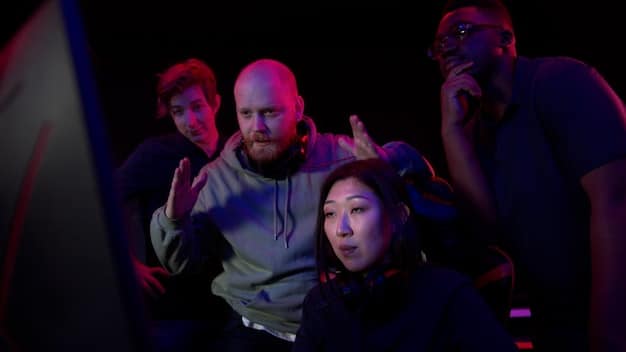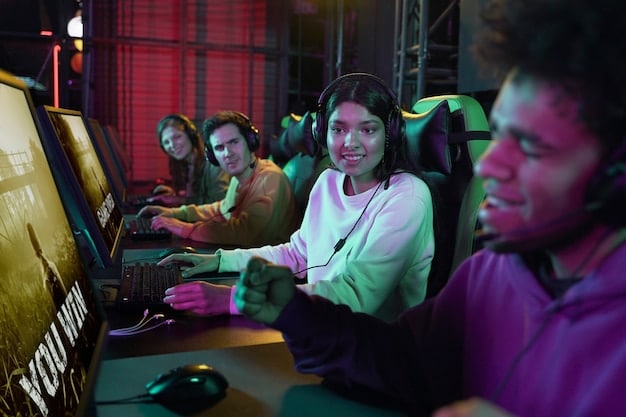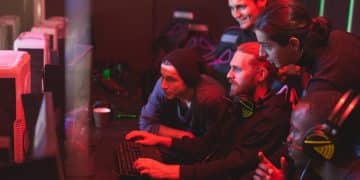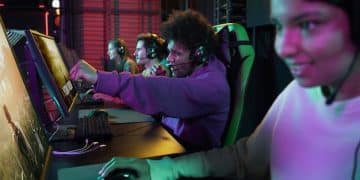Are US Esports Teams Ready for the International Tournament? A Deep Dive

Are US Esports Teams Ready for the Upcoming International Tournament? This article delves into the preparedness of US esports teams for upcoming international competitions, examining their strengths, weaknesses, and strategies for success.
The world of esports is rapidly evolving, and the pressure is on for teams to perform at the highest level. The question on everyone’s mind is: are US esports teams ready for the upcoming international tournament? Let’s dive deep into their prospects.
The Current State of US Esports: An Overview
To assess whether US esports teams are ready for international tournaments, we must first understand the current landscape. US esports has seen significant growth in recent years, with increasing investment and a growing player base.
However, that growth doesn’t necessarily translate to automatic success on the world stage. Let’s take a closer look at the main factors.
Growth and Challenges
The US esports scene has its advantages, but it also faces challenges that could affect performance in international tournaments.
- Investment Increases: More funding and resources are becoming available for US esports teams, leading to better training facilities and support staff.
- Talent Pool: The US has a robust domestic talent pool, with numerous amateur and semi-professional players striving to reach the top level.
- Cultural Expectations: The pressure to perform can be intense, especially when representing one’s country on an international stage.
- Competition Rigor: The level of competition in US domestic tournaments needs to ensure that teams are prepared for international competition.
The key is to optimize existing resources and overcome internal challenges with a focus on sustainable development.

In conclusion, the US esports ecosystem has its potential, but also faces numerous challenges. By properly maximizing resources and overcoming challenges via sustainable development, this ecosystem shows immense potential.
Key Games and US Performance
Certain games dominate the esports landscape, and the performance of US teams in these games is a critical indicator of their readiness for international tournaments. This section will review the major titles which are pivotal to the success of the esports scene.
Let’s look at some key titles and the performance of US teams.
League of Legends (LoL)
League of Legends is one of the most popular esports globally, US teams have had mixed success over the years.
- Past Achievements: US teams have occasionally made deep runs at the World Championship, though outright victories have been rare.
- Current Standing: North American League of Legends Championship Series (NALCS) teams often struggle against their counterparts from Korea, China, and Europe.
- Future Prospects: Investment in talent development and infrastructure is needed to improve competitiveness on the global stage.
Counter-Strike: Global Offensive (CS:GO)
Counter-Strike is a first-person shooter where US teams have historically performed well, but recent years have been challenging.
- Historical Success: US teams, particularly Cloud9, have won major international tournaments in the past.
- Recent Performance: The US CS:GO scene has faced increased competition from European and South American teams, leading to inconsistent results.
- Strategies for Improvement: Focus on team cohesion, strategic depth, and individual player development to compete effectively.
Dota 2
Dota 2 is a complex strategy game where US teams have also experienced mixed results.
- The International: While European and Chinese teams often dominate The International, US teams can sometimes surprise with strong performances.
- Challenges: The steep learning curve and strategic complexity of Dota 2 requires continuous adaptation and innovation.
- Path Forward: US teams must invest in sophisticated analytics, coaching, and team synergy.
In summary, while the US boasts a passionate player base, bridging the gap between domestic fervor and international competitiveness requires persistent effort and strategic adjustments in key esports titles.

Training and Infrastructure: Are They Enough?
The effectiveness of training and infrastructure plays a crucial role in fostering competitive esports teams. Proper investment in these areas can significantly improve a team’s chances of success on the international stage.
Let’s dive into the training and infrastructure of esports teams.
Training Regimens
Rigorous training regimens are essential for any esports team hoping to compete at the highest level.
- Structured Practice: Consistent, scheduled practice sessions that cover various aspects of the game, from technical skills to strategic decision-making.
- Data Analysis: Using advanced analytics tools to identify strengths and weaknesses and adjust strategies accordingly.
- Physical and Mental Fitness: Incorporating physical exercise, mental wellness programs, and stress management techniques to maintain peak performance.
Infrastructure Investments
The right infrastructure can provide a conducive environment for growth and excellence.
- Dedicated Training Facilities: State-of-the-art facilities equipped with top-tier hardware, ergonomic setups, and soundproof rooms to minimize distractions.
- Coaching and Support Staff: Experienced coaches, analysts, sports psychologists, and nutritionists to provide holistic support.
- Living Arrangements: Comfortable living spaces designed to promote rest, relaxation, and team bonding.
Ultimately, the combination of disciplined training regimens and significant infrastructure investments creates a high-performance environment essential for US esports teams aiming for international success.
Financial Backing and Sponsorships
The financial health of an esports team plays a pivotal role in its ability to thrive and compete at the highest levels. Financial backing and sponsorships provide the necessary resources for teams to invest in training, infrastructure, and talent.
The financial implications of investing in esports are critical for success.
The Role of Sponsors
Sponsors provide the financial lifeline that enables esports teams to operate and compete effectively.
- Financial Support: Providing funds for salaries, travel, accommodation, and other operational expenses.
- Equipment and Gear: Supplying top-of-the-line gaming hardware, peripherals, and apparel.
- Promotional Support: Leveraging their marketing channels to increase team visibility and fan engagement.
Investment Landscape
The investment landscape must be robust to foster sustainable growth and competitiveness.
- Venture Capital: Attracting investments from venture capital firms interested in high-growth opportunities.
- Private Equity: Securing funding from private equity firms looking to diversify their portfolios.
- Public Offerings: Exploring the possibility of initial public offerings (IPOs) to raise capital and increase shareholder value.
Sponsorships and strategic investments are critical for ensuring the financial stability of US esports teams, allowing them to grow and compete effectively on the international stage.
Player Development and Scouting
Effective player development and scouting are vital for sustaining a competitive edge. Discovering, nurturing, and honing talent ensures that teams have a constant influx of skilled players ready to compete at the highest level.
Without continuously developing players, teams will not have the depth needed to compete.
Scouting Strategies
Effective scouting strategies enable teams to identify promising talent early on.
- Online Platforms: Monitoring online gaming platforms, leaderboards, and communities to identify standout players.
- Amateur Leagues: Attending grassroots events and amateur leagues to scout emerging talent.
- Data Analytics: Using data analytics tools to assess player performance, identify potential, and predict future success.
Development Programs
Robust development programs nurture the skills and strategic understanding of players.
- Academies: Establishing esports academies to provide structured training, mentorship, and educational resources.
- Scrimmages: Organizing regular scrimmages against top-tier teams to expose players to high-pressure competitive environments.
- Coaching: Providing personalized coaching to improve individual skills, strategic thinking, and teamwork.
By investing in thorough scouting strategies and detailed development programs, US esports teams can build a pipeline of talent to ensure long-term competitiveness on the international stage.
Mental Fortitude and Team Dynamics
Mental fortitude and team dynamics can significantly impact a team’s ability to perform under pressure in international tournaments. Cultivating resilience and fostering strong team cohesion are essential for success.
Let’s look into how mental and team dynamics can effect esports teams.
Psychological Resilience
Building mental resilience is key to overcoming challenges and maintaining peak performance.
- Stress Management: Techniques to manage stress, anxiety, and pressure during high-stakes matches.
- Positive Mindset: Training players to maintain a positive attitude, focus on solutions, and bounce back from setbacks.
- Mental Health Support: Providing access to sports psychologists, counselors, and other mental health professionals.
Cohesive Team Environment
A cohesive team environment promotes effective communication, cooperation, and mutual support.
- Communication Strategies: Encouraging open and effective communication among team members to enhance coordination and decision-making.
- Conflict Resolution: Establishing clear protocols for resolving conflicts and addressing interpersonal issues.
- Team Building Activities: Organizing team-building activities to foster trust, camaraderie, and a sense of shared purpose.
Investing in the mental fortitude and cohesive team dynamics is essential for helping US esports teams perform consistently and rise to the occasion in international competition.
| Key Point | Brief Description |
|---|---|
| 🚀 Investment in Training | More resources for better facilities and support. |
| 🎮 Key Game Performances | Mixed success in League of Legends, CS:GO, and Dota 2. |
| 🧠 Mental Fortitude | Focus on resilience and positive mindset. |
| 🤝 Team Dynamics | Promoting communication and cooperation. |
Frequently Asked Questions
▼
US teams enhance training by implementing structured practice sessions, utilizing data analytics, and integrating physical and mental fitness programs. This comprehensive approach helps players reach peak performance levels.
▼
Sponsorships are vital, providing financial support for salaries, travel, and equipment. Sponsors also increase team visibility through promotional activities, enhancing their overall competitiveness in the esports scene.
▼
Team dynamic is essential for success. Open communication, conflict resolution, and team-building activities foster trust and cooperation, leading to better coordination and decision-making during high-pressure games.
▼
US esports teams scout talent through online platforms, amateur leagues, and data analytics. They develop players through academies, scrimmages, and personalized coaching, building a strong talent pipeline for sustained competitiveness.
▼
Mental fortitude helps players manage stress, maintain a positive mindset, and bounce back from setbacks. Access to mental health professionals ensures they can handle the high-pressure environment of international tournaments.
Conclusion
In conclusion, while US esports teams show promise with increasing investment and talent, they face challenges in key games and need to focus on training, mental fortitude, and team dynamics to achieve consistent success in upcoming international tournaments. Continuous development and strategic planning will be crucial for their readiness and performance on the global stage.





